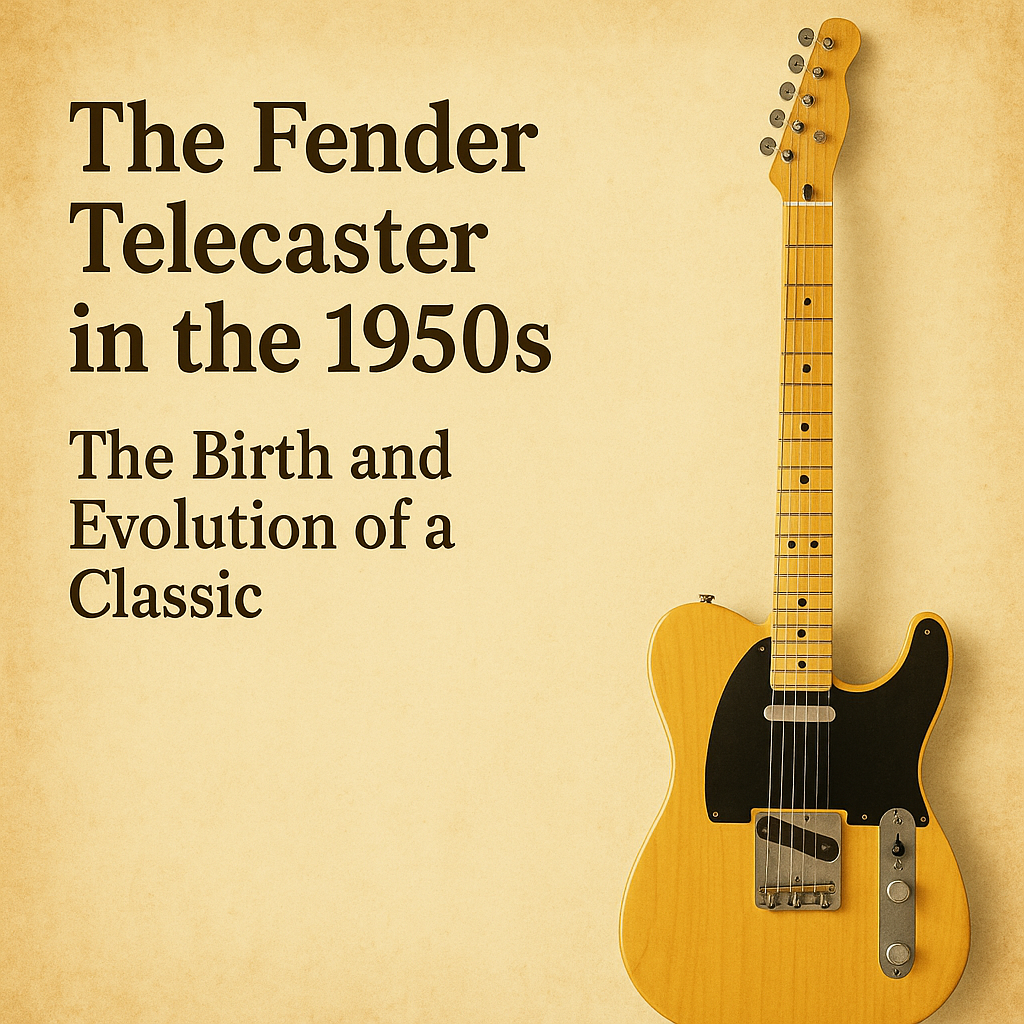The Fender Telecaster is one of the most iconic electric guitars in history, and the 1950s marked its birth and crucial early development. As Leo Fender’s revolutionary solid-body design took shape, the Telecaster not only changed how guitars were built, but also set the tone—literally—for much of modern music. Here’s a closer look at how the Telecaster evolved throughout its first decade.
1950: The Broadcaster Begins It All
In late 1949, Fender began shipping a few prototype versions of its first solid-body electric guitar under the name Esquire, a single-pickup model. By early 1950, a two-pickup version was released as the Broadcaster. These early models featured an ash body, a one-piece maple neck, and a striking but simple “blackguard” design—so named for their distinctive black pickguards.
Key specs:
-
Body: Ash
-
Neck: 1-piece maple
-
Pickups: Single- or dual-coil
-
Bridge: 3-saddle “ashtray” bridge with brass saddles
1951: Name Change to Telecaster
Due to a trademark dispute with Gretsch (which already had a “Broadkaster” drum set), Fender was forced to change the name. For a brief period in early 1951, some guitars were shipped without a model name on the headstock—these are now famously known as “Nocasters.” By mid-1951, the guitar officially became the Telecaster.
This was the model that would come to define the Telecaster lineage: durable, simple, and sonically versatile. Its bright, twangy tone made it a staple in country music, but it quickly found its way into blues, rock, and R&B.
1952–1954: Refinement and Recognition
During these years, the Telecaster saw refinements that enhanced both playability and production efficiency. Fender made small adjustments to body contours, neck shapes, and finishes, but the essential design remained the same.
Notable changes:
-
Slightly thicker neck profiles
-
Consistent use of Butterscotch Blonde nitrocellulose finish
-
Tweaks to the pickup wiring and tone circuit
In these early years, the Telecaster gained popularity with players like James Burton and Luther Perkins, laying the foundation for its eventual ubiquity.
1955–1957: Evolving Production and Neck Profiles
By the mid-1950s, Fender’s production methods improved, allowing for more consistent builds and minor spec changes. In 1955, Fender began transitioning from the “round string tree” to a “butterfly” design. Meanwhile, neck profiles slimmed down slightly, especially by 1956, making them more comfortable for faster playing styles.
This period also marked the shift from flat-pole to staggered-pole bridge pickups—designed to better balance string output.
1958–1959: Aesthetic and Structural Changes
The late 1950s saw more noticeable visual changes to the Telecaster:
-
In 1958, Fender began offering a sunburst finish as an option alongside the classic Blonde.
-
White pickguards replaced the original black phenolic ones, giving the guitar a cleaner, more modern look.
-
The necks began to feature a “slab” rosewood fingerboard instead of a one-piece maple neck, foreshadowing the design shift of the early 1960s.
Structurally, the body wood on some models shifted from ash to alder (particularly for sunburst models), subtly affecting the guitar’s tonal characteristics—making it slightly warmer and rounder.
The Legacy of the 1950s Telecaster
By the end of the 1950s, the Telecaster had solidified its reputation as a workhorse instrument. Its simplicity, durability, and unmatched tonal clarity made it a favourite among session musicians, touring guitarists, and studio players alike.
Today, vintage 1950s Telecasters are among the most sought-after instruments in the world. Their legacy lives on not only through original models but also through Fender’s reissues, Custom Shop builds, and countless copies and tributes across the guitar world.
Whether you’re after that signature twang, a piece of music history, or a reliable tool that won’t let you down, the 1950s Telecaster is where it all began—and it’s still just as relevant today.









